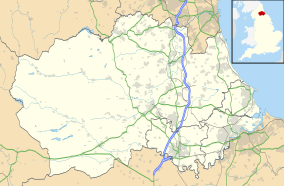Moorhouse and Cross Fell facts for kids
Quick facts for kids Moorhouse and Cross Fell |
|
|---|---|

Summit of Cross Fell, with Great Dun Fell in the distance
|
|
| Location | Teesdale, Durham Eden, Cumbria, North East, England |
| Area | 13,707 ha (52.92 sq mi) |
| Established | 1951 / 1963 |
| Governing body | Natural England |
| Website | Map of site |
Moorhouse and Cross Fell is a very special natural area in England. It's a huge stretch of wild moorland located across parts of County Durham and Cumbria. This amazing place is officially known as a Site of Special Scientific Interest (SSSI). It connects with other important nature sites nearby, like Upper Teesdale SSSI.
The area includes Cross Fell, which is the highest point in the Pennines mountains. At 893 metres high, it's also the tallest peak in England outside the Lake District. This site is important because it has many different kinds of natural habitats. These include wet bogs, high-altitude heaths, and special grasslands. These habitats support a wide variety of animals and plants.
Contents
Amazing Wildlife
Moorhouse and Cross Fell is home to many different animals. It's especially important for its birds and insects.
Birds of the Moorland
More than 40 types of birds make their homes here. Many of these birds are rare or endangered. This means they need special protection to survive.
Some of the amazing birds of prey you might see include:
Many wading birds also live here. These birds have long legs and usually live near water. They include:
- Eurasian golden plover
- Dunlin
- Common sandpiper
- Northern lapwing
- Eurasian curlew
- Common redshank
- Common snipe
Four of these birds (merlin, peregrine, golden plover, and short-eared owl) are so important that they are listed for special protection in Europe. Others, like the lapwing and dunlin, are also considered at risk in the United Kingdom.
Unique Insects
The insects in this area have been studied for many years. Scientists have found some very rare species here. Some of these insects are found almost nowhere else in Britain.
For example, there's a type of rove beetle called Olophrum assimile. It's only known from one other place in Britain. Another rare insect is a ground beetle called Nebria nivalis. This beetle hasn't been found anywhere else in the North Pennines. It's only known from a few other spots in Britain, like North Wales.
In total, over 27 endangered insect species have been recorded here. More than 70 nationally scarce species also live in the Moor House reserve. This shows how incredibly important this area is for insect life.
Special Plants and Habitats
The area has many different habitats, but the plants that grow high up on the mountains are truly special.
Mountain Plants
The very top of Cross Fell is covered in a unique type of heath. A moss called Racromitium lanuginosum grows everywhere here. This is the largest area of this specific moss-heath in all of England.
Other special plants that grow in these high, cool places include:
- Hair sedge (Carex capillaris)
- Northern bedstraw (Galium boreale)
- Mountain everlasting (Antennaria dioica)
- Alpine forget-me-not (Myosotis alpestris)
These plants are adapted to the harsh mountain environment. They help make Moorhouse and Cross Fell a unique place for nature.
Geological Wonders
Moorhouse and Cross Fell also has some fascinating geological features. These are places where the rocks and landforms tell a story about Earth's history.
Knock Fell Caverns
One notable spot is Knock Fell Caverns. This is a very large and complex cave system in Britain. It's like a giant natural maze underground.
Cross Fell Landforms
The area around Cross Fell, including the Dun Fells and Knock Fell, is important for its periglacial landforms. These are shapes in the land created by freezing and thawing processes. Some of these processes are still happening today, showing how the landscape is constantly changing.
Protecting This Special Place
Moorhouse and Cross Fell has a rich history of protection. People have long recognized its importance for nature.
History of Protection
In 1975, the Moor House National Nature Reserve (NNR) became the first site in Britain to be named a Biosphere Reserve by UNESCO. This means it's recognized internationally for its unique ecosystems.
The larger Moorhouse and Cross Fell SSSI was created in 1990. This happened when several existing protected areas were combined. This made the protection of this important natural area even stronger.
Current Designations
Today, the site is part of the North Pennines Area of Outstanding Natural Beauty. This means it's a beautiful landscape that is protected for its special scenery. It's also part of the North Pennines Moors Special Protection Area. This European designation helps protect the rare birds that live here.


